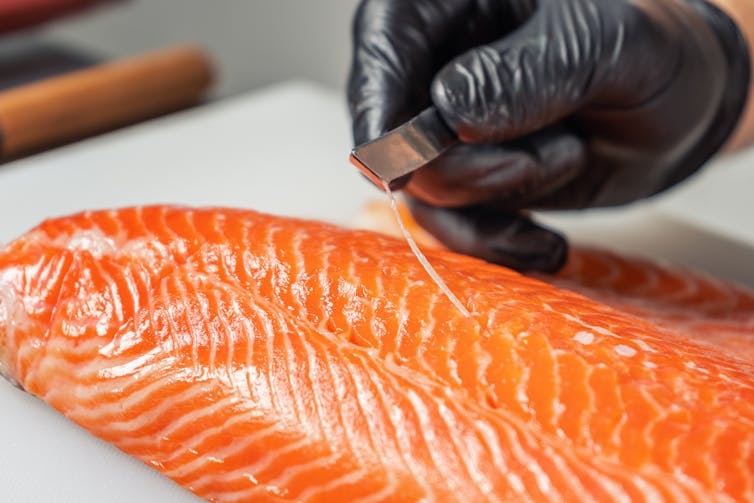- Home
Edition
Africa Australia Brasil Canada Canada (français) España Europe France Global Indonesia New Zealand United Kingdom United States Edition:
Global
Edition:
Global
- Africa
- Australia
- Brasil
- Canada
- Canada (français)
- España
- Europe
- France
- Indonesia
- New Zealand
- United Kingdom
- United States
 Academic rigour, journalistic flair
Academic rigour, journalistic flair
 AYO Production/Shutterstock
Why it’s so easy to choke on fish bones – and the other dangers they pose
Published: November 27, 2025 5.19pm GMT
Adam Taylor, Lancaster University
AYO Production/Shutterstock
Why it’s so easy to choke on fish bones – and the other dangers they pose
Published: November 27, 2025 5.19pm GMT
Adam Taylor, Lancaster University
Author
-
 Adam Taylor
Adam Taylor
Professor of Anatomy, Lancaster University
Disclosure statement
Adam Taylor does not work for, consult, own shares in or receive funding from any company or organisation that would benefit from this article, and has disclosed no relevant affiliations beyond their academic appointment.
Partners
Lancaster University provides funding as a founding partner of The Conversation UK.
View all partners
DOI
https://doi.org/10.64628/AB.nyst7q7my
https://theconversation.com/why-its-so-easy-to-choke-on-fish-bones-and-the-other-dangers-they-pose-270613 https://theconversation.com/why-its-so-easy-to-choke-on-fish-bones-and-the-other-dangers-they-pose-270613 Link copied Share articleShare article
Copy link Email Bluesky Facebook WhatsApp Messenger LinkedIn X (Twitter)Print article
Strictly Come Dancing judge Shirley Ballas recently revealed that she’d “thought that was it” after a fish bone became lodged in her throat. Ballas’s terrifying ordeal lasted for 20 minutes, with the judge struggling to breathe until her hair and makeup artist managed to dislodge the bone using the Heimlich manoeuvre (also known as abdominal thrusts).
Ballas certainly isn’t the first person to make the news for such an ordeal. Even the late Queen Mother had experienced something similar.
Fish bones are actually one of the most common reasons people end up in the emergency department. This phenomenon is particularly common in Asian countries, where diets tend to include a lot of fish. The problem is so great, in fact, that in China specialist fish bone removal clinics have popped up.
Although fish are a good source of many minerals, protein and heart-healthy fatty acids, they also contain multiple small, delicate “pin” bones – usually in the fillet.
Cod have approximately 17 pin bones and salmon have around 30 – though some fish can have over 100. Eel bones have also frequently been linked to emergency room trips, while flounder bones are particularly dangerous because of the number and size of them – making it easy for them to get lodged far down the throat.
This means that despite the care taken during the food prep process, some may inadvertently slip through. These bones can be dangerous if swallowed accidentally – and choking is just one of the serious complications that they can cause.
Fish bones typically become lodged in the tonsils at the back of the throat, in the pharynx at the back of the mouth, the piriform sinus (a small hollow that plays a role in swallowing) and, of course, the oesophagus (the canal which connects the throat to the stomach).
If you do accidentally swallow a fish bone, you’ll probably experience coughing, a prickly or “something stuck” sensation in the throat, as well as pain or difficulty swallowing and spitting up blood.
However, they don’t always cause symptoms – and some people end up living unknowingly with a fish bone stuck in their throat. For instance, in 2012 a 69-year-old Japanese woman went to hospital complaining of a swollen neck – only for doctors to discover she had a 32mm fish bone which had been lodged in her throat for nine months.
Undiscovered fish bones can also migrate around the neck. Repeated swallowing can also result in the bones penetrating the wall of the oesophagus and moving into the tight spaces in the neck.
Here, the bone poses a high risk to the vast number of critical nerves and blood vessels that pass through the neck – such as the carotid artery, which is one of the major vessels that supplies blood to the brain.
 Fish have many small bones which can be missed even during careful food prep.
Roman Samsonov/ Shutterstock
Fish have many small bones which can be missed even during careful food prep.
Roman Samsonov/ Shutterstock
Bones can also pierce the thyroid gland, which can cause abscesses and inflammation. This can also lead to sepsis, a rare but incredibly dangerous complication.
In some cases, lodged fish bones have even managed to migrate into the neck’s muscles and under the skin. They can even pop out the skin too – as happened recently to one Thai woman.
Any bones that manage to migrate out of the throat are a surgical emergency as there’s no way to dislodge it otherwise. These bones can also cause infections in the spaces around the heart, or migrate into the spinal cord leading to secondary infections which could cause paralysis.
This is why it’s imperative that if you do accidentally swallow a bone, you try to remove it as soon as possible.
What to do
Stuck fish bones can be removed in a variety of ways.
For some people, a forceful cough will be enough to eject it. This technique is most effective in cases where the bone is stuck in the airway, rather than the oesophagus.
But one problem with coughing is that instead of ejecting it, it could dislodge the bone and allow it to pass into the stomach and through the intestines, where there’s a risk of perforation.
Bones that are stuck in the wall of the oesophagus could potentially move through the body, but many cases will require endoscopic removal.
Some tips suggest that eating something such as bread or banana can force the bone down, but there’s no scientific evidence to support this remedy. It may even further block the airway or oesophagus – and could potentially make things worse by lodging the bone further into the tissue. So if coughing doesn’t help and you still have symptoms, seeking medical advice is the next sensible step.
Where a person is unable to speak or breathe then abdominal thrusts may be needed to help dislodge the offending fish bone (or other item). If it comes to this, you should call emergency services and seek urgent medical support.
- Fish
- Choking
- Emergency rooms
- Educate me
- Health hazards
Events
Jobs
-
 Senior Lecturer, Human Computer Interaction
Senior Lecturer, Human Computer Interaction
-
University Lecturer in Early Childhood Education
-
 Case Specialist, Student Information and Regulatory Reporting
Case Specialist, Student Information and Regulatory Reporting
-
 Lecturer in Paramedicine
Lecturer in Paramedicine
-
 Associate Lecturer, Social Work
Associate Lecturer, Social Work
- Editorial Policies
- Community standards
- Republishing guidelines
- Analytics
- Our feeds
- Get newsletter
- Who we are
- Our charter
- Our team
- Partners and funders
- Resource for media
- Contact us
-
-
-
-
Copyright © 2010–2025, The Conversation
 Senior Lecturer, Human Computer Interaction
Senior Lecturer, Human Computer Interaction
 Case Specialist, Student Information and Regulatory Reporting
Case Specialist, Student Information and Regulatory Reporting
 Lecturer in Paramedicine
Lecturer in Paramedicine
 Associate Lecturer, Social Work
Associate Lecturer, Social Work

